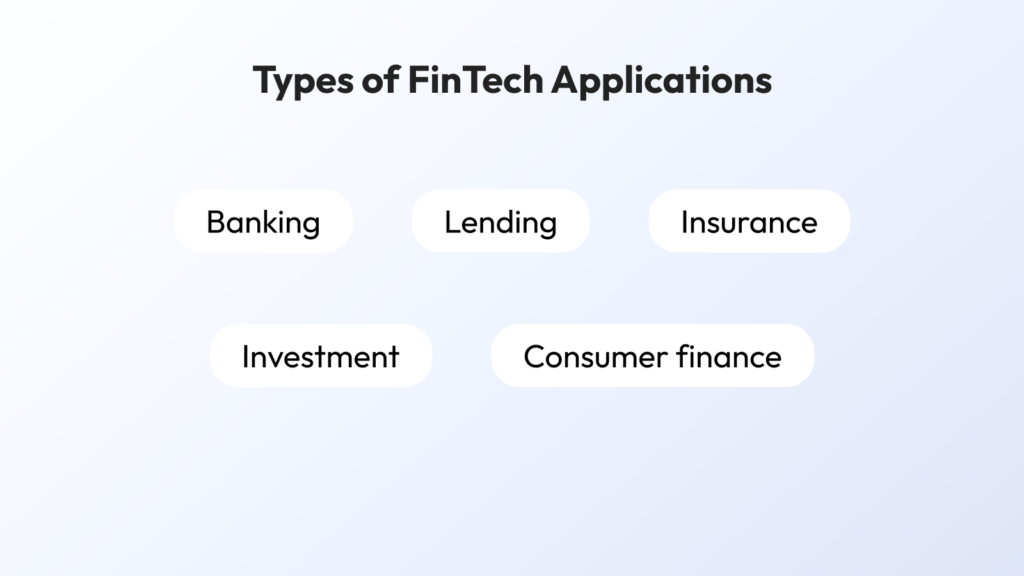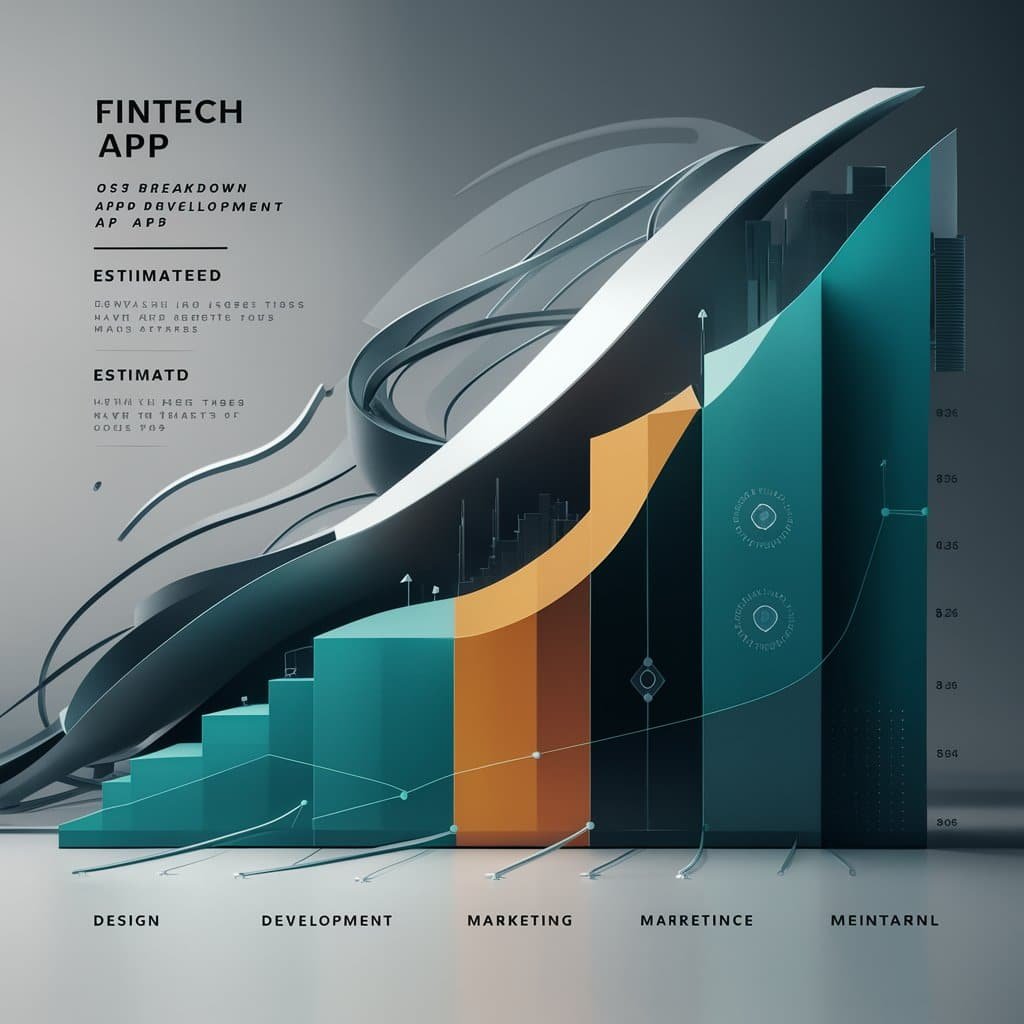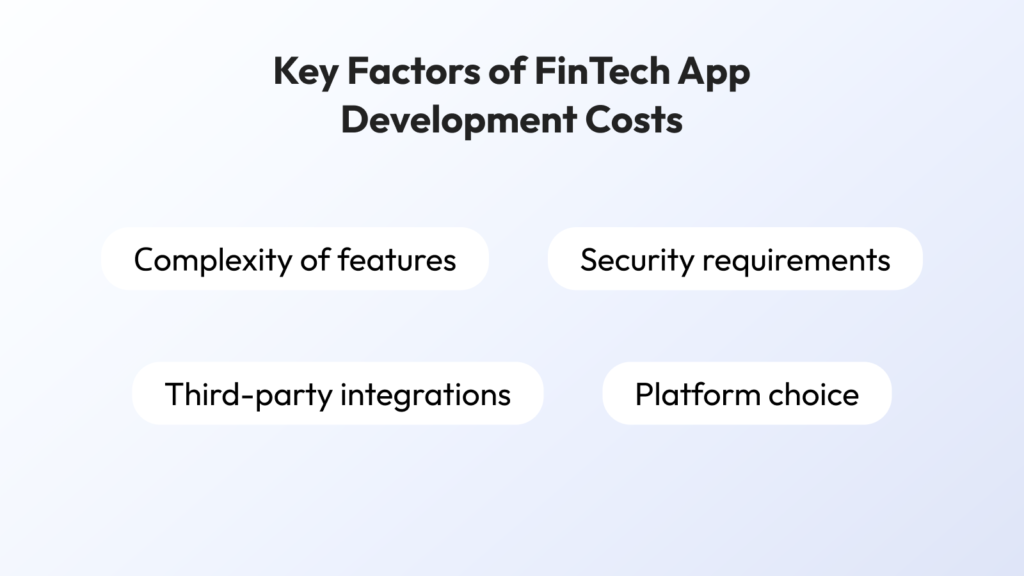FinTech app creation involves far more than coding and UI design. It is about putting in place a secure, trustworthy platform to solve problems present in people’s financial lives. You should be aware of the main challenges and pitfalls of this process to understand the expenses that can be. So, let’s dissect the cost of FinTech app development.
Estimating the Cost of Different Types of FinTech Applications
The first point of understanding the cost is to realize that the type of application you are about to build will seriously influence the final price tag. It can be building an investment platform, budgeting, lending, or insurance app – each contains unique challenges and expenses.

In the case of the simple budgeting app, it won’t be as expensive as a trading platform with real-time updates, advanced algorithms, and integration with several financial institutions. For instance, a simple budgeting application intended to provide the opportunity for users to manage their finances could include only the very basic features of linking bank accounts, setting budgets, and generating reports. Applications like these would be more budget-friendly, costing in the range of $30,000 to $50,000. Contrarily, a full-featured trading application where users can purchase or sell shares in real-time, maintaining a heavier structure of complex backend systems necessary to warrant instant updates on data changes, might go up as high as $100,000 easily.
The Estimation of Banking Application Feature Development Time

For developing banking apps, this has usually concentrated on features dealing with primary account management, transfer operation, bill payments, and recent transaction history. Since banking applications have many regulations and are bound by numerous financial laws, much more time is spent on creating security, data protection, and authentication.
For example, it may take weeks of coding to integrate secure logins, such as those by biometrics or two-factor authentication. Thus, while an elementary-featured basic banking application with essential features will take from 4 to 6 months, a fully featured version with peer-to-peer feature transfers or options for international remittance might reach even 9 months of continuous development.
Estimating Development Time of Lending App Features
Lending applications connect borrowers and lenders, and loan calculators credit scores, and applying directly via the application is usually part of such apps. The time it takes for development will depend upon the complexity of each.
A simple application can be developed within 4 to 6 months, while more complex platforms that include advanced analytics, AI-based lending risk assessments, and integration with third-party credit bureaus may take up to 12 months or even more. The time needed is also influenced by the need for additional steps, such as securing user data and ensuring a smooth and secure payment gateway for loan repayments.
Estimating the Time to Develop the Features of an Insurance App
It would usually include policy management, claims processing, premium payments, and some claim tracking. The complexity arises once you start integrating advanced features. AI-based claim assessments may be integrated, or personal recommendations to customers based on their profiles.
An application that allows users to see their insurance policies and permits them to make a few payments would take 4 to 6 months to develop. However, if you are trying to do something a bit advanced, like instant claim approvals or using machine learning to anticipate customer needs, this might take up to 9 months or even more.
Developing Time Estimation for the Features of Consumer Finance Application
Usually, consumer finance apps contain budgeting tools to feature tracking expenses and savings goals. Others even allow users to monitor their credit scores or manage their subscriptions. While these are relatively simple, they also have to be integrated seamlessly with financial institutions and banking systems.
The basic development of a consumer finance application can be worked out in 4-6 months, but it will easily go up to more than 9 months if an AI-powered insight feature into the spending habit is to be given or some integration with outside financial planning tools is needed.
How Much App Development Cost Varies Based on Location
The location where you will hire your development team determines the cost. For example, a developer from the U.S. or Western Europe has a high rate because of their living standards, ranging from $100 to $250 per hour, as they have high demand and very skilled developers. On the other hand, developers from Eastern Europe or India charge between $30 and $75 per hour, which might be a better price with no loss in quality. You could save up to 30% to 50% on your project if you select a development team located in an affordable region such as Eastern Europe. However, the catch is to deal with a team that can be in a different time zone; sometimes, it delays the communication or project timeline.
Key Factors That Influence FinTech App Development Costs
There are many different aspects that can influence the cost of building a FinTech application. Let’s take a closer look at the main of them:

- The complexity of features: Development cost depends on the level of complexity of the features, such as real-time data updates, AI, and machine learning.
- Security requirements: Financial information falls under the sensitive category. Therefore, building in security features concerning this, like encryption, secure payment gateways, and compliance with various regulations such as GDPR PCI-DSS, enormously increases the cost.
- Third-party integrations: The process of development involves integrating third-party services, such as banks for payment processing or credit bureaus, which further extends the time and cost of the project.
- Platform choice: Designing an app for both iOS and Android will cost more than building for just one platform due to the additional work involved in design, testing, and coding.
Wrapping Up
Creating a FinTech application doesn’t come easily. It consumes a lot of careful planning and, of course, a very good understanding of your audience. The cost would depend on the application type, the features it includes, and even the location of your development team. Once you understand these elements, building expectations will be close to the realistic picture, enabling better decision-making. Be it banking, lending, insurance, or even those apps related to investment, just remember that the real magic of success lies in how valuable it is for your audience and how secure it is for them.
FAQs on FinTech App Development Cost
1. What is a FinTech app, and why is it important?
A FinTech app is a financial technology application that helps users manage their money, make transactions, invest, and access financial services. These apps play a crucial role in making financial processes faster, more accessible, and more secure.
2. How much does it cost to develop a FinTech app?
The cost of FinTech app development varies based on complexity, features, and location of the development team. A basic budgeting app may cost around $30,000 to $50,000, whereas a feature-rich trading platform or banking app can exceed $100,000.
3. What are the key factors affecting FinTech app development costs?
Several factors influence the cost, including:
- Feature complexity (e.g., AI-powered insights, real-time updates)
- Security requirements (e.g., encryption, compliance with regulations)
- Third-party integrations (e.g., payment gateways, credit bureaus)
- Platform choice (Android, iOS, or both)
- Location of the development team (U.S. vs. Eastern Europe or India)
4. How long does it take to build a FinTech app?
Development time varies depending on the app type:
- Basic budgeting apps – 4 to 6 months
- Banking apps – 6 to 9 months
- Lending apps – 4 to 12 months
- Insurance apps – 4 to 9 months
- Consumer finance apps – 4 to 9 months
5. Why does location impact development costs?
Developers in the U.S. and Western Europe charge between $100 to $250 per hour, while developers in Eastern Europe or India charge between $30 to $75 per hour. Hiring from lower-cost regions can reduce overall expenses by up to 50%.
6. What are the biggest challenges in FinTech app development?
- Regulatory compliance (GDPR, PCI-DSS)
- Security risks (fraud prevention, encryption, authentication)
- Scalability (ensuring smooth performance with growth)
- User experience (simple yet powerful UI/UX)
7. Should I develop a FinTech app for iOS, Android, or both?
Developing for both platforms increases reach but also costs more. If budget is a concern, launching on one platform first and expanding later may be a good strategy.
8. Can AI and machine learning impact development costs?
Yes, AI-driven features like fraud detection, credit scoring, and automated financial advice increase costs due to the need for advanced algorithms, data processing, and integrations.
9. How do I choose the right development team for my FinTech app?
Look for teams with:
- Experience in FinTech development
- Strong security expertise
- Understanding of financial regulations
- Positive client reviews and case studies
10. Is it better to develop an app in-house or outsource development?
Outsourcing can reduce costs and provide access to specialized talent, but in-house development offers more control. The best choice depends on your budget, timeline, and technical expertise.




